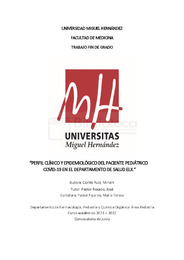Please use this identifier to cite or link to this item:
https://hdl.handle.net/11000/28851Perfil clínico y epidemiológico del paciente pediátrico COVID-19 en el departamento de salud Elx
| Title: Perfil clínico y epidemiológico del paciente pediátrico COVID-19 en el departamento de salud Elx |
| Authors: Cortés Ruiz, Miriam |
| Tutor: Pastor Rosado, Jose Pastor-Fajardo, María Teresa |
| Editor: Universidad Miguel Hernández |
| Department: Departamentos de la UMH::Farmacología, Pediatría y Química Orgánica |
| Issue Date: 2022-05-25 |
| URI: https://hdl.handle.net/11000/28851 |
| Abstract: Introducción: Un nuevo brote de coronavirus apareció en diciembre de 2019 en Wuhan (China). Hasta la fecha, se han confirmado 12.058.888 casos en España. El impacto de la infección por SARS-CoV-2 en niños es diferente al que se observa en adultos. Se ha visto que los niños desarrollan un curso clínico más leve. Objetivos: Describir el perfil clínico y epidemiológico de los pacientes pediátricos COVID-19 + en el departamento de salud Elx. Material y métodos: Estudio analítico observacional longitudinal retrospectivo, realizado en un grupo de niños de 0-15 años diagnosticados de enfermedad por SARS-CoV-2 del departamento de salud del HGUE, de febrero 2020 a junio 2021. Se recogieron variables sociodemográficas, antropométricas, clínicas, diagnósticas y de resultado. Resultados: Se analizaron 174 pacientes, de los cuales el 48,9% fueron mujeres, con una mediana de edad 10 años. El diagnóstico fue mediante PCR en un 81,6% de los sujetos. El 75% de los casos se dieron durante la tercera ola. El 55,2% de los niños presentaron sintomatología, destacando la presencia de cefalea (21,3%), tos (20,1%) y congestión nasal (19%). Los antecedentes médicos más frecuentes fueron el asma, la prematuridad y las cardiopatías congénitas. Un 18% de los sujetos estudiados presentaban sobrepeso u obesidad. El tiempo de recuperación fue mayor en las niñas (p=0,005) y en los mayores de 11 años (p=0,004). No hubo correlación entre ZS-IMC y días de recuperación (r=-0.001, p=0.994) ni duración de los síntomas (r=-0.086, p=0.517). Conclusiones: No hubo diferencias estadísticamente significativas entre sexos. La mayoría de los casos sintomáticos pertenecían a la franja de mayores de 11 años. Hubo una diferencia estadísticamente significativa en el tiempo de recuperación en función del sexo y la edad, siendo mayor en las niñas y >11 años. La obesidad no supuso un factor de riesgo para padecer COVID-19. Introduction: A new outbreak of coronavirus appeared in December 2019 in Wuhan (China). To date, 12,058,888 cases have been confirmed in Spain. The impact of SARS-CoV-2 infection in children is different from that seen in adults. Children have been seen to develop a much milder clinical course. Objectives: To describe the clinical and epidemiological profile of COVID-19+ pediatric patients in the health department Elx. Methods: Retrospective longitudinal observational analytical study carried out in children aged 0-15 years from Elx Health Department, from February 2020 to June 2021. Sociodemographic, clinical, diagnostic and outcome variables were collected. Results: 174 patients were analyzed, 48.9% were women with a median age of 10 years. The diagnosis of 81.6% of the cases was by performing PCR. 75% of the cases occurred during the third wave. Symptomatology was examined in 55.2% of the cases, highlighting the presence of headache (21.3%), cough (20.1%) and nasal congestion (19%). 8% had asthma as a medical history, 5.2% were premature at birth, 4% obesity and 2.9% congenital heart disease. 18% presented overweight or obesity. 18% of the subjects studied were overweight or obese. Recovery time was longer in girls (p=0.005) and in subjects older than 11 years (p=0.004). There was no correlation between ZS-BMI and recovery days (r=-0.001, p=0.994) or duration of symptoms (r=-0.086, p=0.517). Conclusions: There were no statistically significant differences between the sexes. Most of the symptomatic cases belonged to the age group older than 11 years. There is a statistically significant difference in recovery time based on sex and age, being higher in girls and those older than 11 years. Obesity was not a risk factor for more symptomatic or longer-lasting COVID-19 disease. |
| Keywords/Subjects: Coronavirus Sars-COV-2 COVID-19 Salud infantil Condiciones patológicas, signos y síntomas Pronóstico Complicaciones Terapia Programas de vacunación |
| Knowledge area: CDU: Ciencias aplicadas: Medicina |
| Type of document: info:eu-repo/semantics/bachelorThesis |
| Access rights: info:eu-repo/semantics/openAccess |
| Appears in Collections: TFG- Medicina |
.png)

